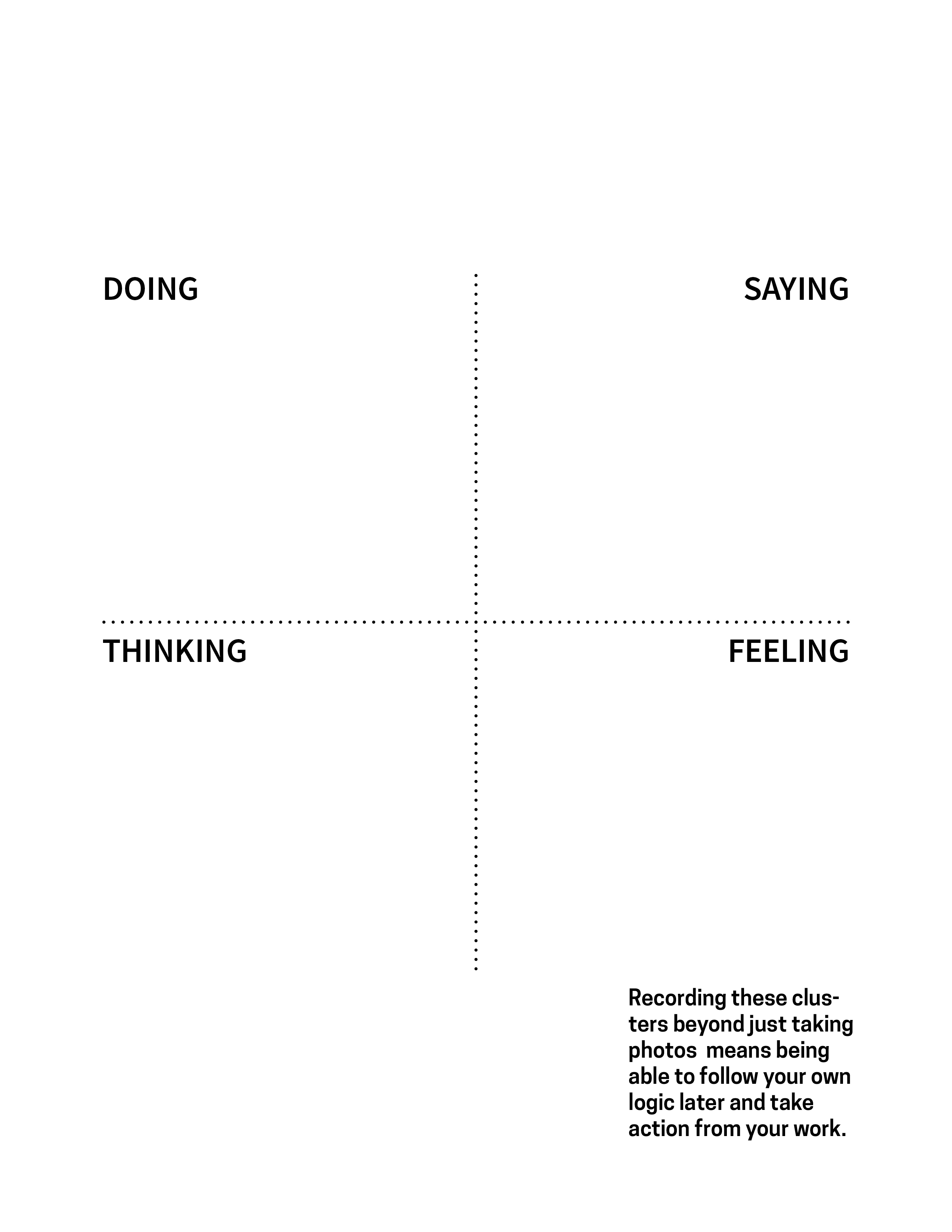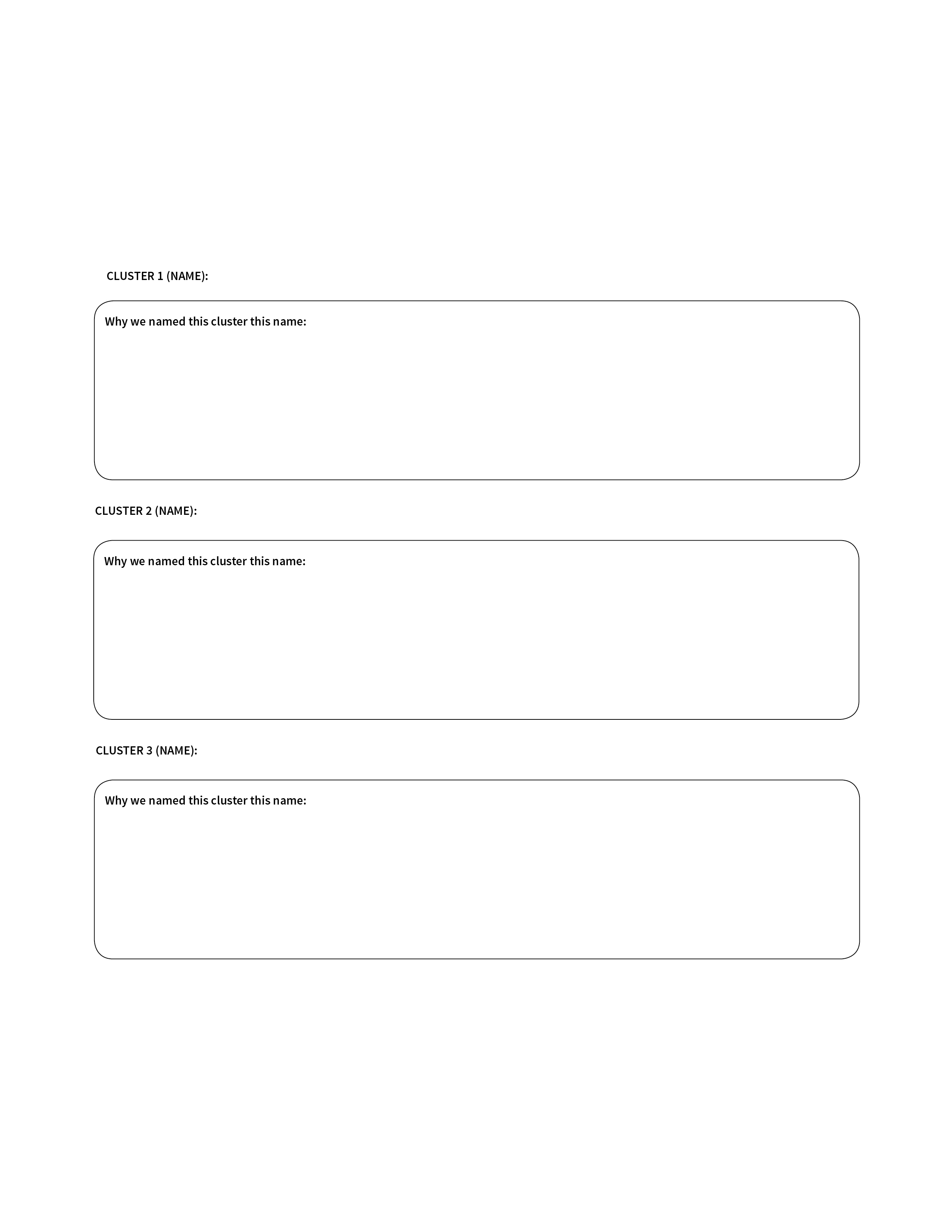Discovery Operations Guide
Insights Methods
Framework - Reading, Questioning, Jotting Notes
Directions for using the framework
- Read Notes: Once the team is gathered, each team member chooses notes from an interview they did not attend, and reads them through. If the team has read all the notes previous to the synthesis session, use this time for clarification of any questions regarding the notes. (see Step 2, paragraph 2). The Project Lead keeps a clock for the reading time. Time: 4 - 6 minutes.
-
After 4 - 6 minutes, the Product Lead should ask everyone if they have any questions for the person whose notes they’re reading.
-
If there is a question, the person whose notes are being queried should provide a clarification. Examples of possible questions are: “What was the context of this statement?” or “What do you mean when you use the word __?” or “Can you explain this to me? I don’t really get it.”
-
The Project Lead should continue the rounds of reading and questioning until everyone has read all of the notes from all of the interviews. This is why it’s important to read as much before you get into the room as possible, so that you can already have questions to ask and move efficiently through this part of the day.
-
Rapid Recall: On sticky notes, one idea per note, each team member should write the most vivid words and phrases they remember from their own research as well as from the research notes. Team members may also jot down words or phrases that merge common themes across the research, like “Scheduling conflicts” to signify a lot of notes on how scheduling is a common pain point heard from multiple interviewees. The Project Lead should repeat this interval as many times as the team needs. Time: 4 minutes / round.
Framework - Primary Clustering Exercise
-
Team members gather their sticky notes and place them on a single wall or the windows of the room.
-
Team members should step back from the wall and start looking for the ideas, words, and phrases that seem to go together. Make meaningful clusters by the concept(s) written on the sticky note; don’t just put similar or the same words together. This is called “clustering”. Time: 10 minutes.
-
Do not be silent! Talk out loud to one another; ask questions, ask opinions.
-
After 10 minutes, the Project Lead should ask if the team needs more time.
-
Repeat the 10 minute intervals as many times as it takes until all or most of the stickies are clustered.
- Use this framework to record the names and justifications for each cluster the team finds.
-
One by one, each team member acts as the leader as the group names each cluster. Everyone on the team must participate both as a group member as well as the leader. To understand how to name the cluster, ask yourselves out loud “What is this cluster about?” or “What does this cluster really mean?” What the clusters are actually saying is your insight. Name the cluster that.
- Take photos of the entire wall. Take some wide shots, take some of the clusters, and some up close up. Make sure you can see all the sticky notes in the photos. If some overlap, move them around so that you can read the writing in the photo.
Framework - Doing, Saying, Thinking, Feeling Analysis
Directions for using the framework
-
Take all the stickies down from the wall, including themes. Set the themes aside.
-
Use the Painters’ tape to mark off a large quadrant on the wall. See the next page for an example.
-
Label each quadrant one of the following: Doing, Saying, Thinking, Feeling.
- Rotating the leadership as before, go through the stack of stickies individually and place them into the quadrants that seem most appropriate.

- Recording these clusters beyond just taking photos means being able to follow your own logic later and take action from your work.
-
As before, do not be silent! The team should ask each other questions in order to land on the most accurate possible interpretation of the stickies in terms of its origin and context.
-
Take photos of the entire wall when you are done, ensuring that you can see each sticky in at least one photo.
-
You can repeat this exercise or the previous one to surface different themes and connections between your data points. This information has a lot of depth and dimension; some concepts have multiple meanings that can be associated with it.
-
Use this space to write down the names of the clusters you and the team find during the Doing, Saying, Thinking,
- Feeling analysis. Keep the names as close to their original position in the quadrants as possible, as the spacial position of each name can be a key part of the logic you and team use in this exercise, even if some of the names span more than one quadrant. If you run out of room, use the other parts of this book or a scrap pieces of paper you can tape, staple or three-hole punch into this book.

